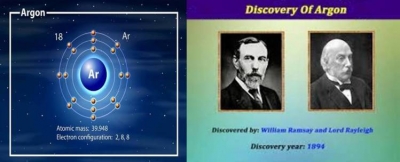
Argon was discovered in 1894. Before that, in 1785, Henry Cavendish had suspected that there was a very interactive gas in our atmosphere but he couldn’t identify it. Later, in 1882, H.F Newall and W.N Hartley looked at the colour spectrum of air and found some strange lines they couldn’t account for. It was in 1894 that Lord Rayleigh and Sir William Ramsay, removed all the oxygen and nitrogen from a sample of air and discovered that it was argon that had caused those strange lines.
Argon is represented by Ar and is a chemical element with atomic number 18. It is in group 18 of the periodic table and is a noble gas. Argon is the most abundant noble gas in our atmosphere.
Argon is chemically very inactive and its name is derived from “argon” which means ‘lazy one’ in Greek. It is colourless, tasteless, odorless and non-toxic in gaseous and liquid forms. It is unreactive (inert) in almost all forms and conditions. As a result, argon doesn’t form any stable compounds at room temperature.
Argon is slightly soluble in water and it has the same solubility as oxygen gas. It is three times more soluble than nitrogen gas in water. Although argon is mostly unreactive, scientists have determined that it can form argon hydrofluoride (HArF) in specific conditions. Planet Mercury has a very thin atmosphere, which contains up to 70 per cent argon.
Picture Credit : Google




